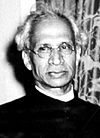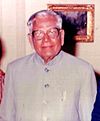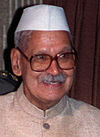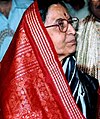THE INDIAN POST OFFICE (AMMENDMENT BILL) IS THE ONLY INSTANCE WHEN PRESIDENT OF INDIA EXERCISED HIS POWER OF VETO.
MAXIMUM LIFE OF THE ORDINANCE OF PRESI 7.5 MONS, ORDINANCE IS DECLARED WHEN COUNCIL OF MINISTERS ADVICE PRESI
PRESIDENT IMPEACHMENT CAN BE INITIATED BY EITHER HOUSE OF THE PARLIMENT
THE RESIDENCE OF PRESIDENT DESIGNED BY EDWARD LUTYENS
| # | Name | Portrait | Took office | Left office | Vice President | Notes |
|---|---|---|---|---|---|---|
| 1 | Rajendra Prasad (1884–1963) |  | 26 January 1950 | 13 May 1962 | Sarvepalli Radhakrishnan | 1952 election page & 1957 election page Prasad was the first President of independent India from Bihar.[8][9] He was also an independence activist of the Indian Independence Movement.[10]Prasad was the only president to serve for two terms in office.[4]k.t.shah rival candidate for him |
| 2 | Sarvepalli Radhakrishnan (1888–1975) |  | 13 May 1962 | 13 May 1967 | Zakir Hussain | 1962 election page Radhakrishnan was a prominent philosopher, writer, a Knight of the Realmand also held the position ofvice chancellor of the Andhra University and Banaras Hindu University.[11] He was also made a Knight of theGolden Army of Angels byPope Paul VI.[12] |
| 3 | Zakir Hussain (1897–1969) | 13 May 1967 | 3 May 1969 | Varahagiri Venkata Giri | 1967 election page Hussain was vice chancellor of the Aligarh Muslim University and a recipient ofPadma Vibhushan andBharat Ratna.[13] He died before his term of office was ended. | |
| Varahagiri Venkata Giri * (1894–1980) | 3 May 1969 | 20 July 1969 | Giri was appointed as Acting President of India following the death of Hussain.[14] He resigned in a few months to take part in the presidential elections.[5] | |||
| Muhammad Hidayatullah * (1905–1992) | 20 July 1969 | 24 August 1969 | Hidayatullah served as theChief Justice of India, and was a recipient of the Order of the British Empire.[15] He served as Acting President of India until the election of Giri as the President of India. | |||
| 4 | Varahagiri Venkata Giri (1894–1980) | 24 August 1969 | 24 August 1974 | Gopal Swarup Pathak | 1969 election page Giri is the only person to have served as both an acting president and president of India. He was a recipient of the Bharat Ratna, and has functioned as Indian Minister of Labour and High Commissioner to Ceylon (Sri Lanka).[16] | |
| 5 | Fakhruddin Ali Ahmed (1905–1977) | 24 August 1974 | 11 February 1977 | Basappa Danappa Jatti | 1974 election page Fakhruddin Ali Ahmed served as a Minister before being elected as president. He died in 1977 before his term of office ended, and was the second Indian president to have died during a term of office.[17] | |
| Basappa Danappa Jatti * (1912–2002) | 11 February 1977 | 25 July 1977 | Jatti was the vice president of India during Ahmed's term of office, and was sworn in asActing President of Indiaupon Ahmed's death. He earlier functioned as the Chief Minister for the State ofMysore.[17][18] | |||
| 6 | Neelam Sanjiva Reddy (1913–1996) |  | 25 July 1977 | 25 July 1982 | Muhammad Hidayatullah | 1977 election page N.S.Reddy was the first Chief Minister of Andhra Pradesh State. Reddy was the only Member of Parliament from the Janata Party to get elected from Andhra Pradesh.[19] He was unanimously elected Speaker of the Lok Sabha on 26 March 1977 and relinquished this office on 13 July 1977 to become the 6th President of India. |
| 7 | Giani Zail Singh (1916–1994) | 25 July 1982 | 25 July 1987 | Ramaswamy Venkataraman | 1982 election page In March 1972, Singh assumed the position of chief Minister of Punjab, and in 1980, he became Union Home Minister.[20] | |
| 8 | Ramaswamy Venkataraman (1910–2009) |  | 25 July 1987 | 25 July 1992 | Shankar Dayal Sharma | 1987 election page In 1942, Venkataraman was jailed by the British for his involvement in the India's independence movement.[21]After his release, he was elected to independent India’s Provisional Parliament as a member of the Congress Party in 1950 and eventually joined the central government, where he first served as Minister of Finance and Industry and later as Minister of Defence.[22] |
| 9 | Shankar Dayal Sharma (1918–1999) |  | 25 July 1992 | 25 July 1997 | Kocheril Raman Narayanan | 1992 election page Sharma was Chief Minister of Madhya Pradesh, and the Indian Minister for Communications. He has also served as the governor of Andhra Pradesh, Punjaband Maharashtra.[23] |
| 10 | Kocheril Raman Narayanan (1920–2005) |  | 25 July 1997 | 25 July 2002 | Krishan Kant | 1997 election page Narayanan served as India's ambassador to Thailand, Turkey, China and United States of America. He received doctorates in Science and Law and was also a chancellor in several universities.[24] He was also the vice-chancellor ofJawaharlal Nehru University.[25] |
| 11 | A. P. J. Abdul Kalam (1931– ) |  | 25 July 2002 | 25 July 2007 | Bhairon Singh Shekhawat | 2002 election page Kalam, is a scientist who played a leading role in the development of India's ballistic missile and nuclear weapons programs.[26] He also received the Bharat Ratna. Kalam was affectionately known as thePeople's President.[27][28][29] |
| 12 | Pratibha Patil (1934– ) |  | 25 July 2007 | 25 July 2012 | Mohammad Hamid Ansari | 2007 election page Patil is the first woman to become the President of India. She was also the first female Governor of Rajasthan.[30][31] |
| 13 | Pranab Mukherjee (1935– ) |  | 25 July 2012 | Incumbent | Mohammad Hamid Ansari | 2012 election page Mukherjee held various posts in the cabinet ministry for theGovernment of India such asFinance Minister, Foreign Minister, Defence Ministerand Deputy Chairman of the Planning Commission.He is from West Bengal and the first Bengali President of the country |
Summary of President’s speech on eve of Republic Day
President calls upon the agencies involved in the delivery of services to work in a transparent, corruption free
and accountable manner.
She says that tremendous work needed to be done to move forward on social and economic agenda if the
country was to achieve fast, inclusive and sustainable growth.
President stressed on the need to adopt constitutional methods to achieve social and economic objectives as also
maintain faith in public institutions like Parliament, the Executive and the Judiciary.
She also called for resolving all issues through dialogue and not through violence. The President also called for
drawing women fully into the national mainstream.
She also said that reinforcing health and education sectors was fundamental for developing the country s human
resources.
Making a strong advocacy for a permanent seat for India in the UN Security Council, the President said India
seeks an architecture for global institutions that was reflective of the contemporary realities.
president
Presidential candidate P.A. Sangma alleged that Congress
is using Raisina Hills for dumping unsuccessful finance Minister Pranab
Mukherjee by nominating and supporting him in the
presidential poll.
What is Raisina Hill ?
Raisina Hill is a region of Lutyens'
Delhi, New Delhi, that houses India's mostimportant government buildings, that
includes Rashtrapati Bhavan, the official residence of the President of India
and the Secretariat building that accommodate the Prime Minister's Office and
several other important ministries. Other important buildings and structures,
including the Parliament
of
India, Rajpath, Vijay Chowk and India Gate surround it.
The
name "Raisina Hill" was given following acquirement of land from 300
families
from X and Malcha villages. About 4,000 acres of land was
acquisitioned
under the "1894 Land Acquisition Act" to begin the creation of
the Viceroy's House. The area is slightly raised, about 226 metres (741 ft)high,
or about 18 metres (59 ft) higher than the surrounding area.In 1911 when
British decided to transfer the capital of British India from Calcutta (now
Kolkata) to Delhi, they set up a planning committee, and a site 3 miles (5 km)
south of the existing city of Delhi, around Raisina Hill, was identified
for establishing new administrative centre. The area located b/w the Delhi
Ridge and the Yamuna River, is well drained and provides sufficient space for
expansion.
the first president of India declared
elected as President without a contest? [A]V V Giri [B]Neelam Sanjeeva Reddy
[C]Shankar Dayal Sharma [D]APJ Abdul Kalam
Neelam Sanjeeva Reddy In 1977 — for the seventh Presidential election — 37
candidates filed their nominations. On scrutiny, the Returning Officer rejected the
nominations filed by 36 candidates. Only one nominated candidate, Neelam
Sanjeeva Reddy, remained in the field who was declared elected unopposed. This
was the first time when a candidate was declared elected as President of India
without a contest
President
The terms
of Varahagiri Venkata Giri, Muhammad Hidayatullah,
and Basappa Danappa Jatti,
who have functioned as acting presidents, are therefore not numbered.
The President of India does not represent any political party. The colours used
in the table indicate the following:
§ The symbol
(*) with a light brown background indicates an Acting President
of India.
#
|
Name
|
Portrait
|
Took
office
|
Left
office
|
Vice
President
|
Notes
|
1
|
26
January 1950
|
13 May
1962
|
1952
election page & 1957
election page
Prasad was the first President of independent India from Bihar.[8][9]He was also an independence activist of the Indian Independence Movement.[10] Prasad was the only president to serve for two terms in office.k.t.shah rival candidate for him |
|||
2
|
13 May
1962
|
13 May
1967
|
1962
election page
Radhakrishnan was a prominent philosopher, writer, a Knight of the Realm and also held the position of vice chancellor of the Andhra University and Banaras Hindu University.[11] He was also made a Knight of the Golden Army of Angels by Pope Paul VI.[12] |
|||
3
|
13 May
1967
|
3 May
1969
|
1967
election page
Hussain was vice chancellor of theAligarh Muslim University and a recipient of Padma Vibhushan andBharat Ratna.[13] He died before his term of office was ended. |
|||
3 May
1969
|
20 July
1969
|
Giri was appointed as Acting
President of India following
the death of Hussain.[14] He
resigned in a few months to take part in the presidential elections.[5]
|
||||
20 July
1969
|
24
August 1969
|
Hidayatullah served as the Chief Justice of
India, and was a recipient of the Order of the
British Empire.[15] He
served as Acting
President of India until
the election of Giri as the President of India.
|
||||
4
|
24
August 1969
|
24
August 1974
|
1969
election page
Giri is the only person to have served as both an acting president and president of India. He was a recipient of the Bharat Ratna, and has functioned as Indian Minister of Labour and High Commissioner to Ceylon (Sri Lanka).[16] |
|||
5
|
24
August 1974
|
11
February 1977
|
1974
election page
Fakhruddin Ali Ahmed served as a Minister before being elected as president. He died in 1977 before his term of office ended, and was the second Indian president to have died during a term of office.[17] |
|||
11
February 1977
|
25 July
1977
|
Jatti was the vice president of
India during Ahmed's term of office, and was sworn in as Acting
President of India upon
Ahmed's death. He earlier functioned as the Chief Minister for the State ofMysore.[17][18]
|
||||
6
|
25 July
1977
|
25 July
1982
|
1977
election page
N.S.Reddy was the first Chief Minister of Andhra Pradesh State. Reddy was the only Member of Parliament from the Janata Party to get elected from Andhra Pradesh.[19] He was unanimously elected Speaker of the Lok Sabhaon 26 March 1977 and relinquished this office on 13 July 1977 to become the 6th President of India. |
|||
7
|
25 July
1982
|
25 July
1987
|
1982
election page
In March 1972, Singh assumed the position of chief Minister of Punjab, and in 1980, he became Union Home Minister.[20] |
|||
8
|
25 July
1987
|
25 July
1992
|
1987
election page
In 1942, Venkataraman was jailed by the British for his involvement in the India's independencemovement.[21] After his release, he was elected to independent India’s Provisional Parliament as a member of the Congress Party in 1950 and eventually joined the central government, where he first served as Minister of Finance and Industry and later as Minister of Defence.[22] |
|||
9
|
25 July
1992
|
25 July
1997
|
1992
election page
Sharma was Chief Minister ofMadhya Pradesh, and the Indian Minister for Communications. He has also served as the governor of Andhra Pradesh, Punjab andMaharashtra.[23] |
|||
10
|
25 July
1997
|
25 July
2002
|
1997
election page
Narayanan served as India's ambassador to Thailand, Turkey, China and United States of America. He received doctorates in Science and Law and was also a chancellor in several universities.[24] He was also the vice-chancellor of Jawaharlal Nehru University.[25] |
|||
11
|
25 July
2002
|
25 July
2007
|
2002
election page
Kalam, is a scientist who played a leading role in the development of India's ballistic missile and nuclear weapons programs.[26] He also received the Bharat Ratna. Kalam was affectionately known as thePeople's President.[27][28][29] |
|||
12
|
25 July
2007
|
25 July
2012
|
2007
election page
Patil is the first woman to become the President of India. She was also the first female Governor of Rajasthan.[30][31] |
|||
13
|
25 July
2012
|
Incumbent
|
2012
election page
Mukherjee held various posts in the cabinet ministry for theGovernment of India such asFinance Minister, Foreign Minister,Defence Minister and Deputy Chairman of the Planning Commission.He is from West Bengal and the first BengaliPresident of the country.[32] |
[
President’s rule
first time in 1951, Punjab
Neelam Sanjeeva Reddy
In 1977 — for the seventh Presidential election — 37 candidates filed
their nominations. On scrutiny, the Returning Officer rejected the nominations
filed by 36 candidates. Only one nominated candidate, Neelam Sanjeeva Reddy,
remained in the field who was declared elected unopposed. Thiswas the first
time when a candidate was declared elected as President of India
without
a contest
hidayathullah---
held posts of president, vice president, chief justice of india
JOINT
PARLIMENATARY COMMITTEE NEVR SET UP IN 2004
MINISTERS AND
DEPARTMENT
CORPORATE
AFFAIRS-
CHAIRMAN OF
NATIONAL INNOVATION COUNCIL--- SAM PITRODA
PM’S ADVISOR ON
SKILL DEVELOPMENT---S.RAMADORAI
NATIONAL
COMMISION
For education
chairman in1964---d.s.kothari
SC- P.L.PUNIA
BC-
Bicameral
legislature
StateLegislature type Size
Uttar Pradesh Bicameral 404 + 108
Maharashtra Bicameral 289
+ 78
Bihar Bicameral 243 + 96
Karnataka Bicameral 224 + 75
Jammu and Kashmir Bicameral 89 + 36
Andhra Pradesh Bicameral 295 + 90
Panchayat raj-
started in 1959
Nagaland- no
panchayat raj institution
National emergencies proclaimed under article 352
National emergency is caused by
war, external aggression or armed rebellion in the whole of India or a part of its territory. Such an
emergency was declared in India in 1962 (Indo-China war), 1971 (Indo-Pakistan
war), and 1975 (declared by Indira Gandhi to maintain law and order in the
country).
High court
Judges appt by
president
ERNAKULAM H.
C JURIS FORKERALA AND LAKSHWADEEP
Can have
jurisdiction over 2 or more states
Madras h c is
the juris for pondyv
President on 9-day state visit to Seychelles and South Africa
The President Mrs.Pratibha Devi Singh Patil is on a 9-day state visit to the Seychelles and South Africa. She will discuss
issues of bilateral, regional and International concerns with her counterparts in the two nations. Increasing bilateral
trade relations with both the African countries is high on the agenda.









No comments:
Post a Comment